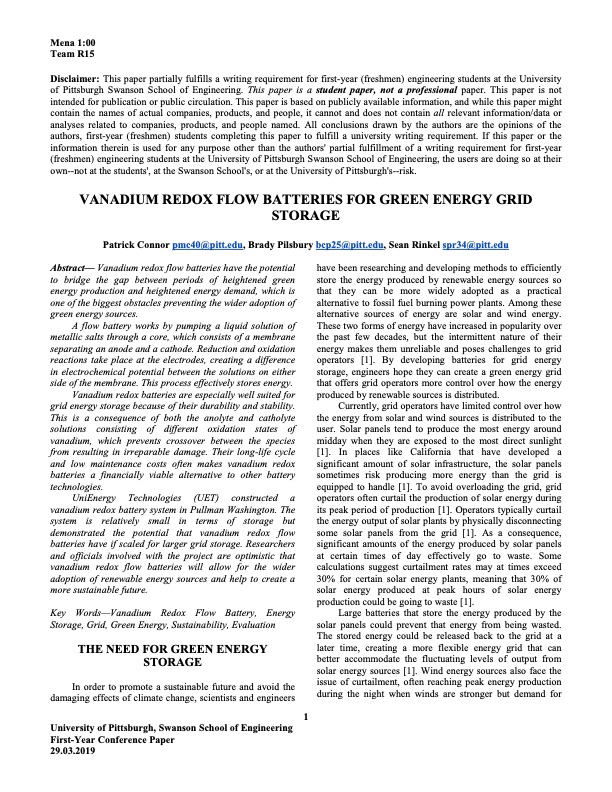
PDF Publication Title:
Text from PDF Page: 001
Mena 1:00 Team R15 Disclaimer: This paper partially fulfills a writing requirement for first-year (freshmen) engineering students at the University of Pittsburgh Swanson School of Engineering. This paper is a student paper, not a professional paper. This paper is not intended for publication or public circulation. This paper is based on publicly available information, and while this paper might contain the names of actual companies, products, and people, it cannot and does not contain all relevant information/data or analyses related to companies, products, and people named. All conclusions drawn by the authors are the opinions of the authors, first-year (freshmen) students completing this paper to fulfill a university writing requirement. If this paper or the information therein is used for any purpose other than the authors' partial fulfillment of a writing requirement for first-year (freshmen) engineering students at the University of Pittsburgh Swanson School of Engineering, the users are doing so at their own--not at the students', at the Swanson School's, or at the University of Pittsburgh's--risk. VANADIUM REDOX FLOW BATTERIES FOR GREEN ENERGY GRID STORAGE Patrick Connor pmc40@pitt.edu, Brady Pilsbury bcp25@pitt.edu, Sean Rinkel spr34@pitt.edu Abstract— Vanadium redox flow batteries have the potential to bridge the gap between periods of heightened green energy production and heightened energy demand, which is one of the biggest obstacles preventing the wider adoption of green energy sources. A flow battery works by pumping a liquid solution of metallic salts through a core, which consists of a membrane separating an anode and a cathode. Reduction and oxidation reactions take place at the electrodes, creating a difference in electrochemical potential between the solutions on either side of the membrane. This process effectively stores energy. Vanadium redox batteries are especially well suited for grid energy storage because of their durability and stability. This is a consequence of both the anolyte and catholyte solutions consisting of different oxidation states of vanadium, which prevents crossover between the species from resulting in irreparable damage. Their long-life cycle and low maintenance costs often makes vanadium redox batteries a financially viable alternative to other battery technologies. UniEnergy Technologies (UET) constructed a vanadium redox battery system in Pullman Washington. The system is relatively small in terms of storage but demonstrated the potential that vanadium redox flow batteries have if scaled for larger grid storage. Researchers and officials involved with the project are optimistic that vanadium redox flow batteries will allow for the wider adoption of renewable energy sources and help to create a more sustainable future. Key Words—Vanadium Redox Flow Battery, Energy Storage, Grid, Green Energy, Sustainability, Evaluation THE NEED FOR GREEN ENERGY STORAGE In order to promote a sustainable future and avoid the damaging effects of climate change, scientists and engineers 1 University of Pittsburgh, Swanson School of Engineering First-Year Conference Paper 29.03.2019 have been researching and developing methods to efficiently store the energy produced by renewable energy sources so that they can be more widely adopted as a practical alternative to fossil fuel burning power plants. Among these alternative sources of energy are solar and wind energy. These two forms of energy have increased in popularity over the past few decades, but the intermittent nature of their energy makes them unreliable and poses challenges to grid operators [1]. By developing batteries for grid energy storage, engineers hope they can create a green energy grid that offers grid operators more control over how the energy produced by renewable sources is distributed. Currently, grid operators have limited control over how the energy from solar and wind sources is distributed to the user. Solar panels tend to produce the most energy around midday when they are exposed to the most direct sunlight [1]. In places like California that have developed a significant amount of solar infrastructure, the solar panels sometimes risk producing more energy than the grid is equipped to handle [1]. To avoid overloading the grid, grid operators often curtail the production of solar energy during its peak period of production [1]. Operators typically curtail the energy output of solar plants by physically disconnecting some solar panels from the grid [1]. As a consequence, significant amounts of the energy produced by solar panels at certain times of day effectively go to waste. Some calculations suggest curtailment rates may at times exceed 30% for certain solar energy plants, meaning that 30% of solar energy produced at peak hours of solar energy production could be going to waste [1]. Large batteries that store the energy produced by the solar panels could prevent that energy from being wasted. The stored energy could be released back to the grid at a later time, creating a more flexible energy grid that can better accommodate the fluctuating levels of output from solar energy sources [1]. Wind energy sources also face the issue of curtailment, often reaching peak energy production during the night when winds are stronger but demand forPDF Image | VANADIUM REDOX FLOW BATTERIES FOR GREEN ENERGY

PDF Search Title:
VANADIUM REDOX FLOW BATTERIES FOR GREEN ENERGYOriginal File Name Searched:
c11-vanadium-redox-flow-batteries.pdfDIY PDF Search: Google It | Yahoo | Bing
Salgenx Redox Flow Battery Technology: Salt water flow battery technology with low cost and great energy density that can be used for power storage and thermal storage. Let us de-risk your production using our license. Our aqueous flow battery is less cost than Tesla Megapack and available faster. Redox flow battery. No membrane needed like with Vanadium, or Bromine. Salgenx flow battery
| CONTACT TEL: 608-238-6001 Email: greg@salgenx.com | RSS | AMP |